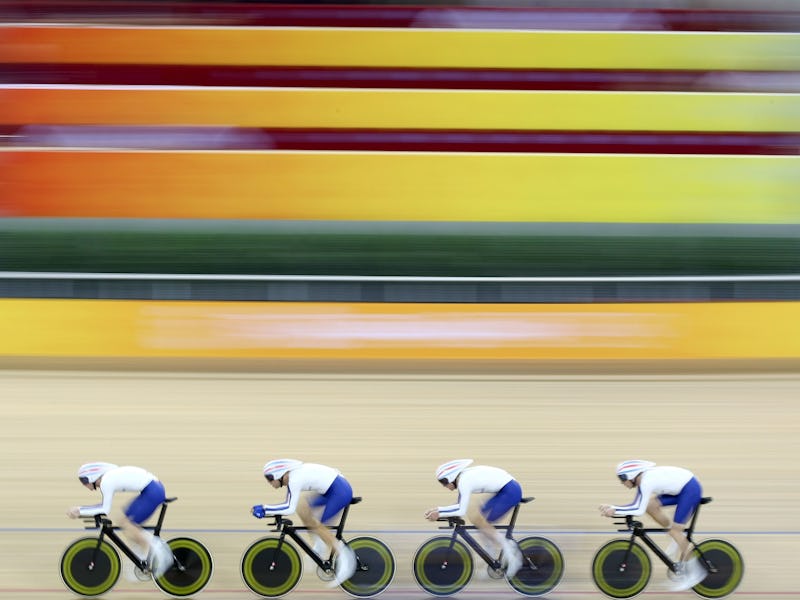An Experimental Drug Could Help Athletes Avoid "Hitting the Wall"
It's all about saving some sugar for your brain.

Hitting the wall during an intense workout feels very strange: Your body seems like it’s no longer attached to your brain, and muscle movements begin to feel impossible. When this happens, “mind over matter” can only get you so far. But why does this happen? And more importantly, how can athletes get over the wall?
On Tuesday, scientists reported in the journal Cell Metabolism that a new chemical might give those athletes a boost.
“We were very excited about the findings, not only the identification of a new mechanism of how exercise works but also that we can mimic such exercise effects with a chemical,” Michael Downes, Ph.D., a molecular biologist and endocrinologist at Salk Institute for Biological Studies in California and a researcher involved with the paper, tells Inverse.
Here’s what intense exercise looks like on a molecular level: When athletes hit a wall, it’s because they’re running low on glucose, a simple carbohydrate. Muscles can get energy from either glucose or fatty acids, but brains can only get energy from glucose. The well-trained muscles of an athlete generally consume more fatty acids than glucose, leaving the lion’s share of glucose for the brain and other tissues. But when all that glucose is consumed, up comes the wall. That’s when things get really tough for muscles and brains alike.
What Downes and his colleagues discovered, however, is a nuclear receptor that enables muscles to consume more fatty acids and less glucose, enabling someone to run longer. When the levels of this receptor — called peroxisome proliferator-activated receptor delta (PPARd) — were artificially increased in mice, the rodents were able to run up to 100 minutes longer than their peers. The receptor-boosting chemical was an experimental drug, ominously codenamed GW501516.
Downes says this workaround for intense athletic training in mice may also hold promise for future human applications.
In the top part of this image, muscle consumes glucose and fatty acids during exercise. In the bottom part, muscle that's been stimulated by PPARd consumes mostly fatty acids, leaving more glucose for the brain.
“Our study identified glucose as the limiting factor in endurance determination in mice,” Downes says. “Although we haven’t done any human study, the common metabolic pathways in mouse and human highly suggest that the same mechanism would explain the ‘hitting the wall’ effect in human athletes.”
This research, once scientists figure out how to apply it to humans, could be used to help break the barriers of human athletic performance, including the fabled two-hour marathon. It’s still early days for this kind of study, of course, so it will probably be quite some time before we see a pill that can help you jump off the couch and run a marathon without collapsing. Oh yeah, and there could be some side effects.
“This study is rather a pilot experiment in developing human drugs that mimic the effects of exercise,” says Downes. “The particular drug GW501516 has side effects that prohibits its usage in humans, but we’re optimistic that the next-generation PPARd agonists with a better safety profile will be available soon.”
Downes says that as scientists continue working on the chemical associated with this research, they could find other applications for PPARd-stimulating drugs. “Some health applications for PPARd agonists include protection against obesity, diabetes, muscle dystrophy, fatty liver disease, and muscle atrophy,” he says.
Abstract:
Management of energy stores is critical during endurance exercise; a shift in substrate utilization from glucose toward fat is a hallmark of trained mus- cle. Here we show that this key metabolic adaptation is both dependent on muscle PPARd and stimulated by PPARd ligand. Furthermore, we find that muscle PPARd expression positively correlates with endur- ance performance in BXD mouse reference popula- tions. In addition to stimulating fatty acid metabolism in sedentary mice, PPARd activation potently sup- presses glucose catabolism and does so without affecting either muscle fiber type or mitochondrial content. By preserving systemic glucose levels, PPARd acts to delay the onset of hypoglycemia and extends running time by $100 min in treated mice. Collectively, these results identify a bifurcated PPARd program that underlies glucose sparing and highlight the potential of PPARd-targeted exercise mimetics in the treatment of metabolic disease, dystrophies, and, unavoidably, the enhancement of athletic performance.